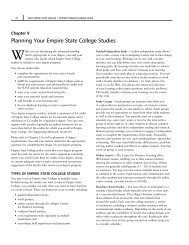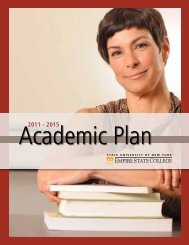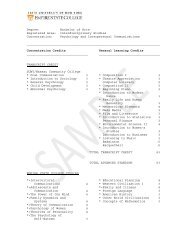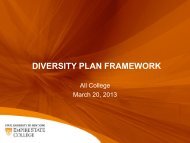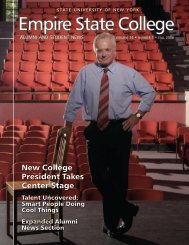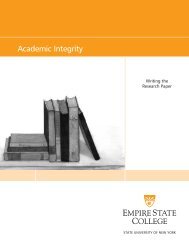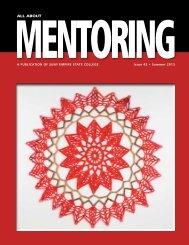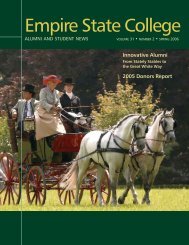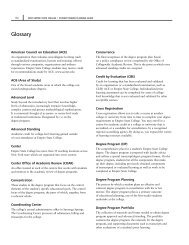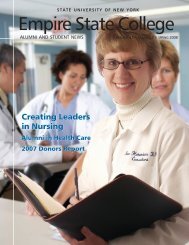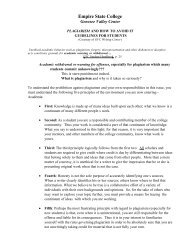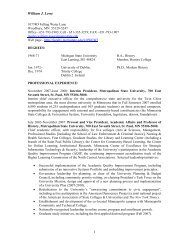All About Mentoring Spring 2011 - SUNY Empire State College
All About Mentoring Spring 2011 - SUNY Empire State College
All About Mentoring Spring 2011 - SUNY Empire State College
You also want an ePaper? Increase the reach of your titles
YUMPU automatically turns print PDFs into web optimized ePapers that Google loves.
69<br />
“Goin’ Mobile”: Designing for Mobility<br />
in Networked Social Spaces<br />
Thomas P. Mackey, Center for Distance Learning<br />
A Review of:<br />
Open Learning 25(3)<br />
Special Issue<br />
Mobile Learning: Using Portable<br />
Technologies to Create New Learning<br />
In 1971, the same year <strong>Empire</strong><br />
<strong>State</strong> <strong>College</strong> was established, Pete<br />
Townshend sang about the freedom of<br />
the open road in the rock anthem “Goin’<br />
Mobile.” In the days of analog, when music<br />
was organized by sequenced tracks, this<br />
song was in a fixed position on side two of<br />
The Who’s classic LP “Who’s Next.” Forty<br />
years later, we remember or imagine what it<br />
was like back then by listening to this disc<br />
and recalling the sounds that dominated<br />
FM radio for at least a decade. From the<br />
minimalist synthesizer that opens “Baba<br />
O’Reilly” to Roger Daultrey’s primal scream<br />
that closes “Won’t Get Fooled Again,” this<br />
album defined rock music of the 1970s. The<br />
work itself emerged from the disconnected<br />
pieces of an unfinished project, Lifehouse,<br />
a proposed film that was intended to evolve<br />
over time with collaborative interaction<br />
with concert audiences (Atkins, 2000, p.<br />
14). As a fragmented collection of songs<br />
that developed from a failed project, “Who’s<br />
Next” works as a postmodern song cycle,<br />
defined not so much by the authority of<br />
the author to create the narrative, but<br />
as an open-ended piece constructed and<br />
understood by individual interpretation and<br />
collective memory.<br />
The free form FM radio format of the ’70s<br />
allowed for the play of multiple tracks from<br />
this record, demonstrating the power of<br />
randomness and sense-making, an idea that<br />
re-emerged 40 years later in Apple’s iPod<br />
Shuffle. This one track in particular, “Goin’<br />
Mobile,” accelerated forward declaring<br />
mobility as a way of life: “When I’m<br />
drivin’ free the world’s my home.” Similar<br />
in many ways to other Pete Townshend<br />
compositions, this song asserts the power<br />
of youth – a disenchanted and rebellious<br />
youth, elevated and empowered by rock<br />
music, while embracing nascent technologies<br />
such as synthesizers and tape machines.<br />
Thematically, this song demonstrates the<br />
ability either individually or collectively to<br />
envision a future and move freely on the<br />
open expansive highway. In 1971, The Who<br />
played some of these songs at the Saratoga<br />
Performing Arts Center (SPAC), breaking<br />
attendance records at this venue with nearly<br />
The Who<br />
30,000 fans, and providing a social context<br />
for this music in Saratoga <strong>Spring</strong>s and the<br />
Capital District (McMichael and Lyons,<br />
2004).<br />
From Analog to Digital<br />
The sense of mobility that is celebrated<br />
in this song, even if told from the<br />
perspective of a privileged rock star on<br />
the road, reflects the revolution of the<br />
era and the ongoing momentum toward<br />
a shifting networked future. Forty years<br />
later, the way we experience music has<br />
transformed considerably from the analog<br />
“tape machine” mentioned in the song, to<br />
photo by peter j. corrigan<br />
multiple portable devices such as the Nano<br />
or Shuffle, smart phone, netbook, MP3<br />
player or digital tablet, allowing access<br />
to the Internet from anywhere, at times<br />
convenient for the user. In the ’70s, records<br />
and tapes were containers for music, and<br />
now we experience the music itself as pure<br />
information, less tangible as a thing found<br />
within a sleeve on vinyl or cassette, and<br />
now a transparent digital binary, easily<br />
downloaded, copied, mashed up, and shared<br />
though multiple digital devices. Listeners are<br />
now active contributors, downloading and<br />
sharing digital content in numerous formats,<br />
ranking and reviewing tracks, and uploading<br />
their own works as user-generated content.<br />
From Digital to Mobile<br />
Our understanding of mobility continues<br />
to change as the cell phone evolves into<br />
an all-purpose smart device for doing<br />
much more than making a phone call, and<br />
the laptop morphs into a digital tablet.<br />
Mobile apps connect us to news sources,<br />
radio streams, music sites, digital libraries,<br />
interactive maps, search engines and social<br />
networking resources such as Facebook,<br />
Twitter, LinkedIn and WordPress Blogs.<br />
Through a collaborative social network, we<br />
post, tweet, text, interact, read, write, share,<br />
and produce information continuously and<br />
interactively. According to Chris Anderson<br />
and Michael Wolff (2010), the mobile<br />
revolution has already taken place. In their<br />
Wired article “The Web is Dead: Long Live<br />
the Internet,” the authors make a convincing<br />
argument that we have moved beyond<br />
the Web browser as the primary mode for<br />
connecting online, and toward increased<br />
mobility with smart phones and apps.<br />
Although we are comfortable accessing<br />
the Web through a browser, Anderson<br />
and Wolff argue that: “the Web is not the<br />
culmination of the digital revolution” (p. 1).<br />
The authors shift the focus from the Web<br />
browser to the larger Internet, and how we<br />
use it to communicate, create and interact<br />
suny empire state college • all about mentoring • issue 39 • spring <strong>2011</strong>




